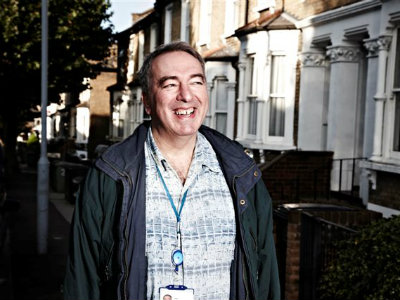
Having seen the previous two episodes of this Channel 4 documentary series about the South London and Maudsley Trust, I was looking forward to this one. The first two looked at an OCD unit and an inpatient psychiatric assessment unit respectively, and most of the time the programmes showed people with mental disorders and mental health professionals in a sympathetic light.
The third programme followed the courageous Jim Thurkle, a mental health social worker and approved mental health professional (AMHP) from Speedwell community mental health team in south London, as he went about his job of trying to maintain and support mentally-ill people in the community. Being a social worker and AMHP in a CMHT myself, I could readily identify with this often frustrating task.
Jim was a star. Throughout the programme he came across as professional, compassionate, empathic and caring. He combined an innate respect for the service users with a little humour, to engage with people who were often difficult and evasive. He was an excellent advertisement for community-based social work.
‘The importance of diligence, persistence and infinite patience’
The programme showed the importance of diligence, persistence, and infinite patience. It showed Jim trying to track down Rosemary, who had disengaged and stopped taking her medication. Having become increasingly worried about her mental state, he visited her with a psychiatrist, and was shown first being rebuffed, and then having an awkward conversation with Rosemary as she disappeared down the road. Unfortunately, this scene was accompanied by Benny Hill-type background music, which I felt detracted from the serious nature of what was happening..
This encounter led to Jim’s conclusion that it was going to be necessary to assess Rosemary under the Mental Health Act. I got quite excited at this prospect – a real Mental Health Act assessment on TV!
Disappointingly, the entire process occupied less than five minutes of air time. We saw Jim arrive with two doctors. We saw him talk to the ambulance crew. (The ambulance there before the assessment? This is certainly not the experience of most AMHP’s!) A neighbour let them into the flat, and Jim and the doctors disappeared inside. And that was just about that. We saw one of the doctors giving Jim the paperwork, then we saw Rosemary meekly entering the ambulance. As Jim said later: “There’s a bit about Rosemary that knows she’s not well.”
While I do understand that the camera crew and the professionals had to respect the right of the patient to privacy in such a fraught situation, it would have been nice to have seen more of the interview and subsequent discussion between professionals.
Stories of improvement
For those who might have felt uncomfortable about Rosemary being deprived of her liberty, there was an encouraging scene later with Jim visiting her at home. Rosemary was clearly very well. She was friendly and open, and did not bear Jim a grudge.
In fact, most of the patients we saw managed to avoid hospital admission. One woman, with a delusional disorder centering on bed bugs, was at one point visited by Jim and a psychiatrist, but this did not result in an admission. Jim felt that, despite her apparently chaotic lifestyle, she was improving. She was later shown more stable and with a degree of insight, having avoided another hospital admission.
This illustrated the importance of having extensive background knowledge of a service user and of building a working relationship. An AMHP seeing this woman in isolation, with no prior knowledge, might easily have detained her.
Moments that grated
There were a few moments in the programme that grated – the off screen producer at one point said to a patient: “Some people are scared of the mentally ill in the community.” I wondered what his point was – was he trying to provoke the patient, or was he trying to drum up alarm among viewers?
And why on earth, in what was otherwise a sensible and rational fly-on-the-wall documentary, did they at one point suddenly decide to put a triple echo on the word “mentally”?
But these are minor criticisms. All in all, I thought this programme showed a sympathetic view of social work with people with mental disorder, and provided considerable insight into the lives of people with mental illness and the professionals who try to help them.
The author blogs as The Masked AMHP and is on Twitter @Masked AMHP.


 Assistive technology and dementia: practice tips
Assistive technology and dementia: practice tips  A trauma-informed approach to social work: practice tips
A trauma-informed approach to social work: practice tips 




 Find out how to develop your emotional resilience with our free downloadable guide
Find out how to develop your emotional resilience with our free downloadable guide  Develop your social work career with Community Care’s Careers and Training Guide
Develop your social work career with Community Care’s Careers and Training Guide  ‘Dear Sajid Javid: please end the inappropriate detention of autistic people and those with learning disabilities’
‘Dear Sajid Javid: please end the inappropriate detention of autistic people and those with learning disabilities’ Ofsted calls for power to scrutinise children’s home groups
Ofsted calls for power to scrutinise children’s home groups Seven in eight commissioners paying below ‘minimum rate for home care’
Seven in eight commissioners paying below ‘minimum rate for home care’
 Facebook
Facebook X
X LinkedIn
LinkedIn Instagram
Instagram
Comments are closed.